Unit 3 The world meets China Starting Out课件(共30张PPT) 外研版(2019)选择性必修第四册
文档属性
| 名称 | Unit 3 The world meets China Starting Out课件(共30张PPT) 外研版(2019)选择性必修第四册 | 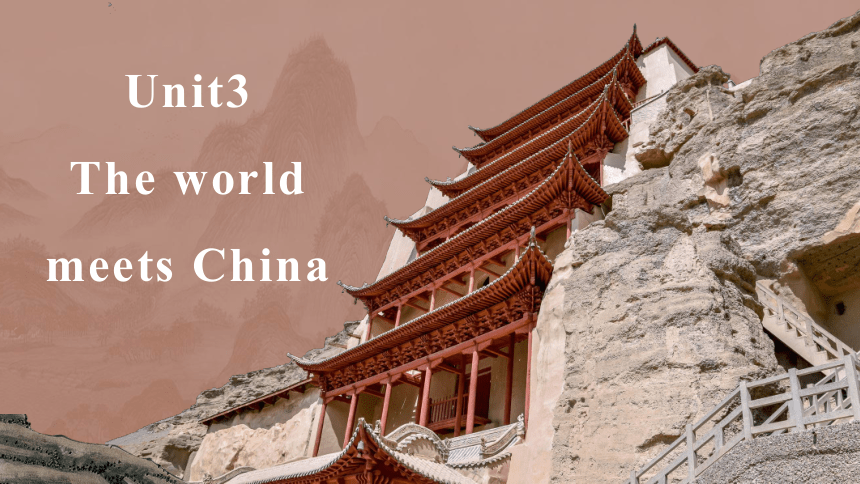 | |
| 格式 | pptx | ||
| 文件大小 | 30.5MB | ||
| 资源类型 | 教案 | ||
| 版本资源 | 外研版(2019) | ||
| 科目 | 英语 | ||
| 更新时间 | 2025-07-29 17:52:55 | ||
图片预览

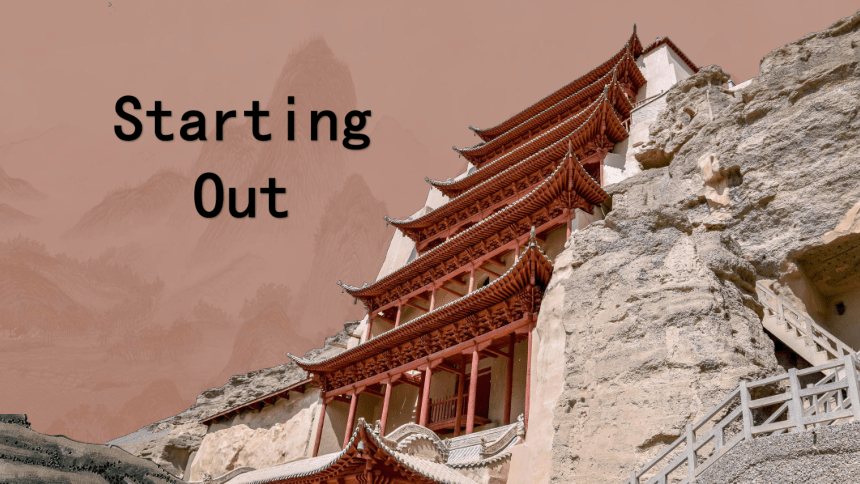
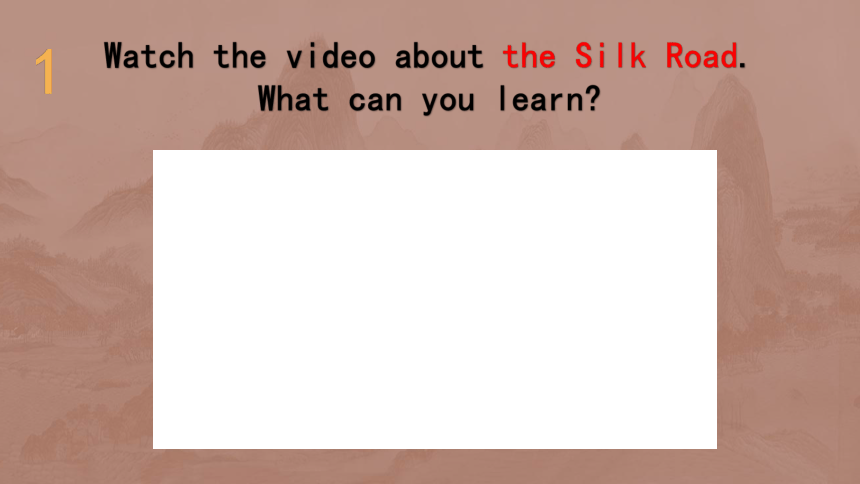
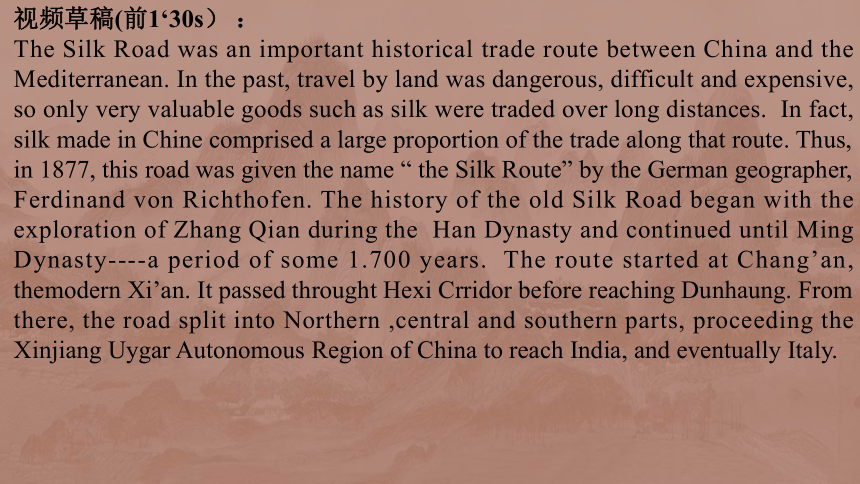
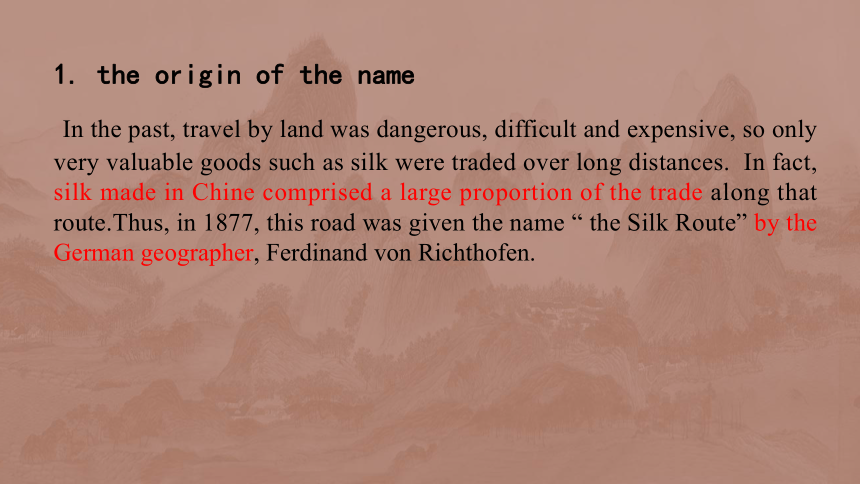
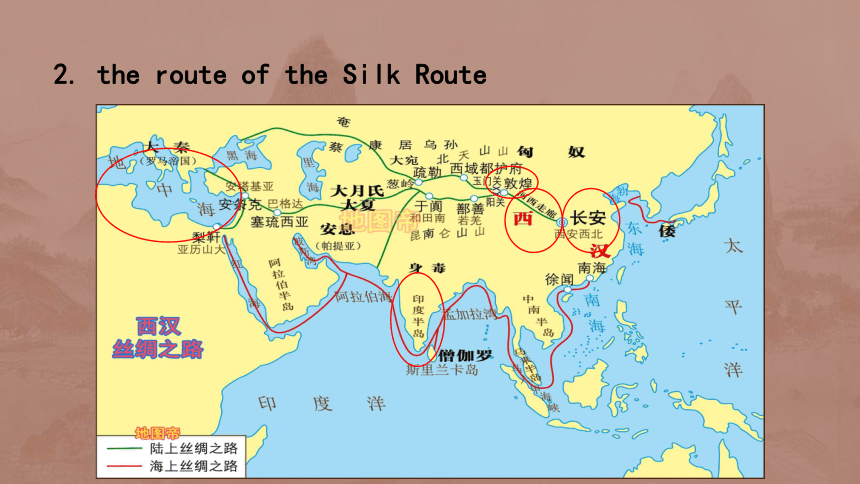
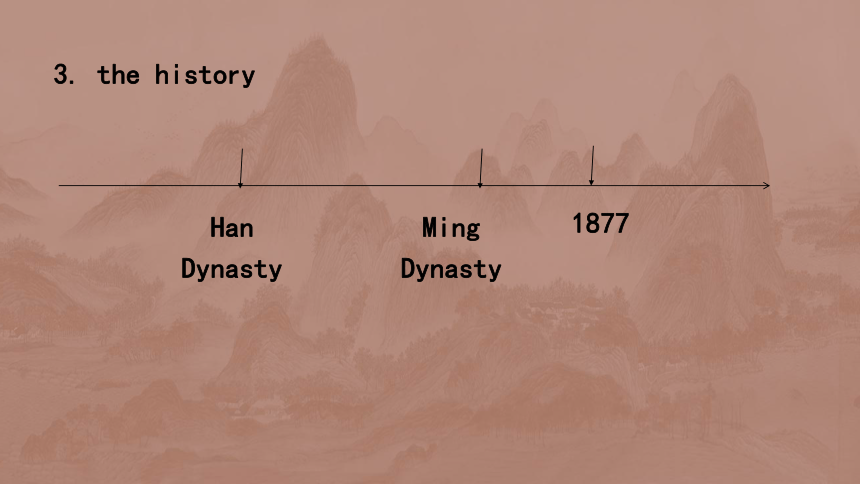
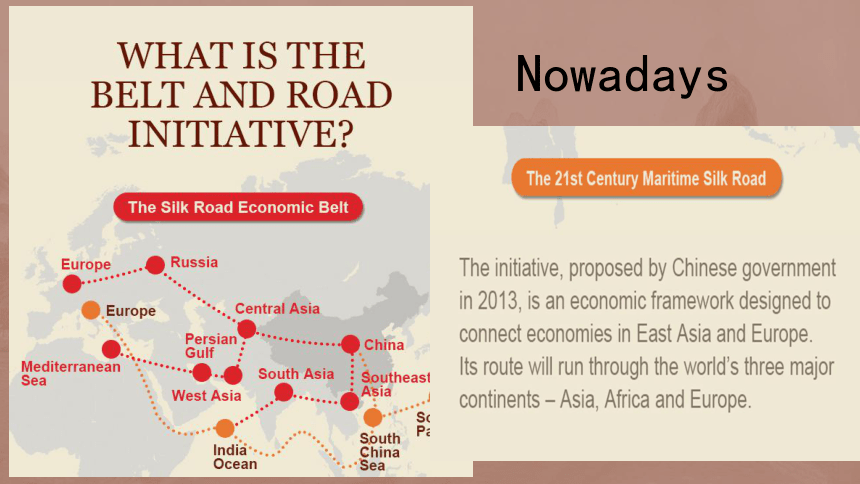
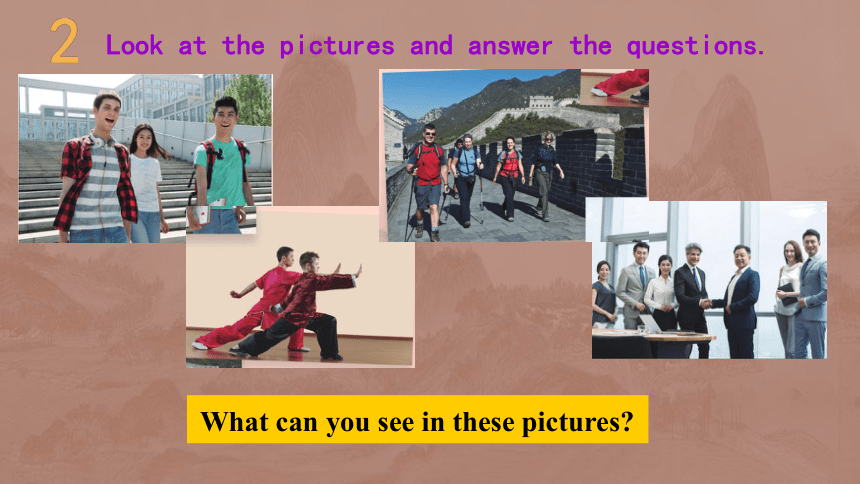
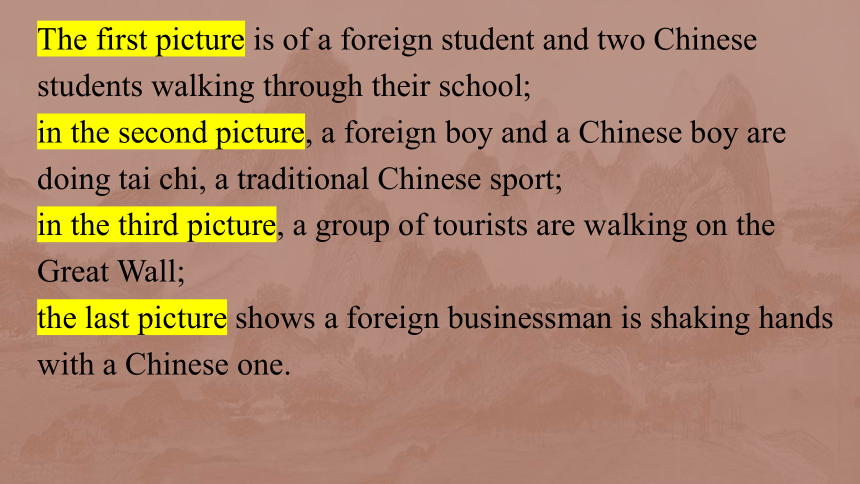


文档简介
(共30张PPT)
Unit3
The world meets China
Starting
Out
Watch the video about the Silk Road.
What can you learn
1
视频草稿(前1‘30s) :
The Silk Road was an important historical trade route between China and the Mediterranean. In the past, travel by land was dangerous, difficult and expensive, so only very valuable goods such as silk were traded over long distances. In fact, silk made in Chine comprised a large proportion of the trade along that route. Thus, in 1877, this road was given the name “ the Silk Route” by the German geographer, Ferdinand von Richthofen. The history of the old Silk Road began with the exploration of Zhang Qian during the Han Dynasty and continued until Ming Dynasty----a period of some 1.700 years. The route started at Chang’an, themodern Xi’an. It passed throught Hexi Crridor before reaching Dunhaung. From there, the road split into Northern ,central and southern parts, proceeding the Xinjiang Uygar Autonomous Region of China to reach India, and eventually Italy.
In the past, travel by land was dangerous, difficult and expensive, so only very valuable goods such as silk were traded over long distances. In fact, silk made in Chine comprised a large proportion of the trade along that route.Thus, in 1877, this road was given the name “ the Silk Route” by the German geographer, Ferdinand von Richthofen.
1. the origin of the name
2. the route of the Silk Route
3. the history
Han Dynasty
Ming Dynasty
1877
Nowadays
Look at the pictures and answer the questions.
What can you see in these pictures
2
The first picture is of a foreign student and two Chinese students walking through their school;
in the second picture, a foreign boy and a Chinese boy are doing tai chi, a traditional Chinese sport;
in the third picture, a group of tourists are walking on the Great Wall;
the last picture shows a foreign businessman is shaking hands with a Chinese one.
Understanding
ideas
The route of the Silk Road
Do you know
tourist attractions
in Dun Huang?
tourist attractions in Dun Huang
Mogao Grottoes
What do you know about
the Mogao Grottoes
background knowledge
9-story pogoda
grotto
cave
mural
statue
The Library Cave
This is a tour commentary :
导游词
Are there sentences that a guide can use ?
Are there sentences that a guide can use ?
welcome to DunHuang
Now, we are going to enter some caves.
Look at tese statues!
Come a little bit closer so that you can get a better view.
Take a look at this mural.
Move over here
This is a tour commentary :
Match the paragraphs to key words.
Mogao Grottoes
Apsaras
the Library Cave
introduction
the fading
back to life/revival
activity 1. the significance of Dunhuang (Para1-2)
It was the gateway to and from Ancient China.
It was a place where East met West.
It was a green island in the middle of the desert.
It is a centre of cultural and commercial exchange.
It is a world-class tourist destination.
Dunhuang
oasis
_________________________ that are testimony证据 to how the Silk Road brought East and West together.
Look at these Statues! They have elements from ___________________.
3. There are murals on the wall, which ____________ of 45,000 square metres.
What are involved in the caves?
the tour commentary: Now we are going to enter some caves. ( para2 )
Paintings and other artworks
Ancient Greece, India and Iran .
cover an area
Let’s appreciate the murals!
Activity 3. The murals (Para3)
The subject of the mural __________________________________
vary (v.) from religious stories to scenes of everyday life
莫高窟第375窟 (佛)乘象入胎
莫高窟第249窟 (道)雷神 西魏
头部及手足为兽形,
双翅,臂生绿毛。
莫高窟雷公形象与东汉王充《论衡》的描绘完全相符。
What’re the values of the caves
Activity 3. The murals (Para3)
The subject of the mural __________________________________
vary (v.) from religious stories to scenes of everyday life
莫高窟第12窟 婚嫁图 晚唐
What’re the values of the caves
Activity 3. The murals (Para3)
The Apsaras, or “Flying Immortals”
They are depicted sailing in the bright blue sky, with their scarves flying, as if they are about to fly down to meet us.
the tour commentary:
Move over here where you can see it in more detail. ( para3 )
What do these murals reflect
hold lotus
play musical instruments
dance and throw flowers
Confidence and optimism of people from that time.
Activity 4. The Library Cave (Para4)
2. What are hidden in the Library Cave
1. Who discovered it When
the tour commentary:
We ‘ll have a chance to see some of them shortly---
the Library Cave is only a stone’s throw from here.
Dating from 405AD to 1002 AD, these hidden treasures give us a picture of ___________________________
Dunhuang when it was at the very centre of the Silk Road Trade
Dunhuang was at the very centre of the Silk Road Trade.
1.Goods arrived in Dunhaung from as far away as _________.
Goods were exported from Dunhuang across_____________.
2. From scrolls ,we know:
______________________________________________________________,
such as ceramics and medicine.
North-east Europe
Asia and Europe
the vast range of goods that were imported and exported from Dunhuang
Activity 5. the fading and the revival (Para5,6)
Ming Dynasty:_________________
Today:
it has once again____________
It faded from memory
become a global crossroads
Revival through China’s ______________________
the Belt and Road Initiative
Tang Dynasty:
being prosperous
Activity 6. After reading: What have we leaned
activity 1. the significance of Dunhuang (Para1-2)
activity 2: Now we are going to enter some caves. ( para2 )
Activity 3. The murals (Para3)
Activity 4. The Library Cave (Para4)
Activity 5. the fading and the revival (Para5,6)
What impressed you most
What’s your feelings
Unit3
The world meets China
Starting
Out
Watch the video about the Silk Road.
What can you learn
1
视频草稿(前1‘30s) :
The Silk Road was an important historical trade route between China and the Mediterranean. In the past, travel by land was dangerous, difficult and expensive, so only very valuable goods such as silk were traded over long distances. In fact, silk made in Chine comprised a large proportion of the trade along that route. Thus, in 1877, this road was given the name “ the Silk Route” by the German geographer, Ferdinand von Richthofen. The history of the old Silk Road began with the exploration of Zhang Qian during the Han Dynasty and continued until Ming Dynasty----a period of some 1.700 years. The route started at Chang’an, themodern Xi’an. It passed throught Hexi Crridor before reaching Dunhaung. From there, the road split into Northern ,central and southern parts, proceeding the Xinjiang Uygar Autonomous Region of China to reach India, and eventually Italy.
In the past, travel by land was dangerous, difficult and expensive, so only very valuable goods such as silk were traded over long distances. In fact, silk made in Chine comprised a large proportion of the trade along that route.Thus, in 1877, this road was given the name “ the Silk Route” by the German geographer, Ferdinand von Richthofen.
1. the origin of the name
2. the route of the Silk Route
3. the history
Han Dynasty
Ming Dynasty
1877
Nowadays
Look at the pictures and answer the questions.
What can you see in these pictures
2
The first picture is of a foreign student and two Chinese students walking through their school;
in the second picture, a foreign boy and a Chinese boy are doing tai chi, a traditional Chinese sport;
in the third picture, a group of tourists are walking on the Great Wall;
the last picture shows a foreign businessman is shaking hands with a Chinese one.
Understanding
ideas
The route of the Silk Road
Do you know
tourist attractions
in Dun Huang?
tourist attractions in Dun Huang
Mogao Grottoes
What do you know about
the Mogao Grottoes
background knowledge
9-story pogoda
grotto
cave
mural
statue
The Library Cave
This is a tour commentary :
导游词
Are there sentences that a guide can use ?
Are there sentences that a guide can use ?
welcome to DunHuang
Now, we are going to enter some caves.
Look at tese statues!
Come a little bit closer so that you can get a better view.
Take a look at this mural.
Move over here
This is a tour commentary :
Match the paragraphs to key words.
Mogao Grottoes
Apsaras
the Library Cave
introduction
the fading
back to life/revival
activity 1. the significance of Dunhuang (Para1-2)
It was the gateway to and from Ancient China.
It was a place where East met West.
It was a green island in the middle of the desert.
It is a centre of cultural and commercial exchange.
It is a world-class tourist destination.
Dunhuang
oasis
_________________________ that are testimony证据 to how the Silk Road brought East and West together.
Look at these Statues! They have elements from ___________________.
3. There are murals on the wall, which ____________ of 45,000 square metres.
What are involved in the caves?
the tour commentary: Now we are going to enter some caves. ( para2 )
Paintings and other artworks
Ancient Greece, India and Iran .
cover an area
Let’s appreciate the murals!
Activity 3. The murals (Para3)
The subject of the mural __________________________________
vary (v.) from religious stories to scenes of everyday life
莫高窟第375窟 (佛)乘象入胎
莫高窟第249窟 (道)雷神 西魏
头部及手足为兽形,
双翅,臂生绿毛。
莫高窟雷公形象与东汉王充《论衡》的描绘完全相符。
What’re the values of the caves
Activity 3. The murals (Para3)
The subject of the mural __________________________________
vary (v.) from religious stories to scenes of everyday life
莫高窟第12窟 婚嫁图 晚唐
What’re the values of the caves
Activity 3. The murals (Para3)
The Apsaras, or “Flying Immortals”
They are depicted sailing in the bright blue sky, with their scarves flying, as if they are about to fly down to meet us.
the tour commentary:
Move over here where you can see it in more detail. ( para3 )
What do these murals reflect
hold lotus
play musical instruments
dance and throw flowers
Confidence and optimism of people from that time.
Activity 4. The Library Cave (Para4)
2. What are hidden in the Library Cave
1. Who discovered it When
the tour commentary:
We ‘ll have a chance to see some of them shortly---
the Library Cave is only a stone’s throw from here.
Dating from 405AD to 1002 AD, these hidden treasures give us a picture of ___________________________
Dunhuang when it was at the very centre of the Silk Road Trade
Dunhuang was at the very centre of the Silk Road Trade.
1.Goods arrived in Dunhaung from as far away as _________.
Goods were exported from Dunhuang across_____________.
2. From scrolls ,we know:
______________________________________________________________,
such as ceramics and medicine.
North-east Europe
Asia and Europe
the vast range of goods that were imported and exported from Dunhuang
Activity 5. the fading and the revival (Para5,6)
Ming Dynasty:_________________
Today:
it has once again____________
It faded from memory
become a global crossroads
Revival through China’s ______________________
the Belt and Road Initiative
Tang Dynasty:
being prosperous
Activity 6. After reading: What have we leaned
activity 1. the significance of Dunhuang (Para1-2)
activity 2: Now we are going to enter some caves. ( para2 )
Activity 3. The murals (Para3)
Activity 4. The Library Cave (Para4)
Activity 5. the fading and the revival (Para5,6)
What impressed you most
What’s your feelings
